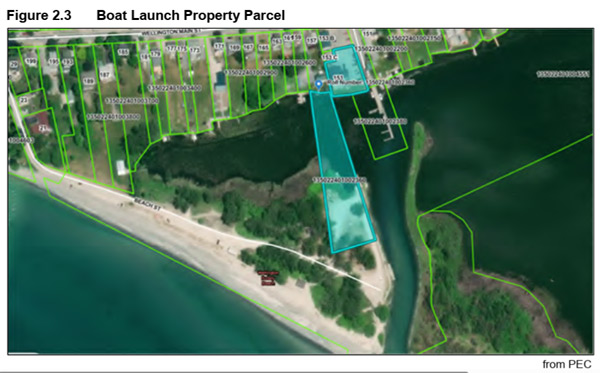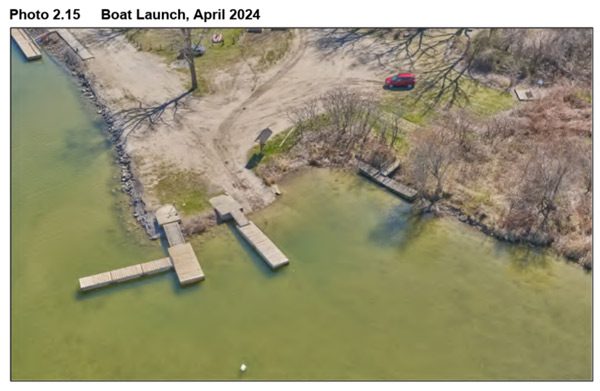Approved plan to improve Wellington beach needs funding
Administrator | Oct 26, 2025 | Comments 6

By Sharon Harrison
“Wellington Rotary Beach is a big feature, especially to visitors to the County; sometimes it’s the first thing, or maybe the only thing, they see when Sandbanks is too full,” expressed councillor John Hirsch.
Council approved the preferred Wellington beach improvement and management plan at the recent committee of the whole meeting. However, it was noted that no work can commence until such time as funds are obtained, which is an on-going process.
“This is a culmination to explore management options for the beach. It consolidates all the past reports and the studies and all the extensive consultations that have been done with residents,” said Albert Paschkowiak, supervisor of environmental services and sustainability.
The plan is to seek funding sources and grants to support unfunded aspects of the plan and the project is to be completed in phases if sufficient grant money is secured.
Council also agreed staff will continue to retain a contractor to dredge the Wellington channel every three years. They will also continue to explore technological advancements and opportunities to purchase a dredge in the future, and to report back to council with details as viable options are identified.
With respect to the 2026 budget, Hirsch brought forward an amending motion that would see staff present into the budget a reserve for climate adaptation and mitigation projects.
Those funds will cover the required contribution to participate in an FCM (Federation of Canadian Municipalities) climate adaptation grant for the Wellington beach improvement plan, and/or other climate adaptation projects.
Hirsch explained how FCM funding is available in terms of climate change adaptation and would cover 70 per cent of the project, leaving the municipality to find the other 30 per cent. He further added that FCM won’t accept an application if the municipality can’t say that it has the 30 per cent available, so hence the need to put something in the budget.
“That should enable us to do some of the major items, the big start-up items that need to be done before the others, quickly, possibly as soon as next year,” added Hirsch.
Paschkowiak confirmed those items that would qualify for a climate adaptation project, noting the most prevalent items would relate to re-grading and re-working of the road.
“Part of this plan is to putting in proper drainage and we are also raising it up with proper drainage, so if there are storms, the water doesn’t sit there and work away at the road. We would be looking at re-working the grading, looking at the drainage, looking at bioswale.”
He said the reason why they are talking about the road first is because everything else is dependent on that.
The preferred beach improvement and management plan focuses on addressing key issues at Wellington beach, especially channel sedimentation, beach infrastructure (such as roads and buildings) and user access.
 Preferred beach improvement management plan cost estimates come to a total of $1.46 million, made up as follows (further descriptions at end of article):
Preferred beach improvement management plan cost estimates come to a total of $1.46 million, made up as follows (further descriptions at end of article):
Re-grade road and parking plus new culvert: $150,000
Asphalt removal and new paving: $510,000
New boardwalk and armour-stone barrier: $240,000
Dune and berm construction: $230,000
Overland wind and wave barrier: $70,000
Bioswale: $160,000
Raise picnic shelter: $26,000
Replace change house: $52,000
Kayak launch, storage rack and lockers: $22,000.
Additional costs include average annual dredging cost at $50/metre³: $72,000
Annual survey and monitoring: $15,000.
Paschkowiak said it represents a “cost conscious, minimalist approach” to managing the property and addressing the fundamental issues it is experiencing, particularly sedimentation, flooding, poor drainage, deterioration of the road, and also parking and folks driving on the beach.
Dredging is the first priority – already funded and is to proceed next year.
 Discussion around the horseshoe included funding resources, the cost of paving the beach road, dredging options, should the municipality be in the business of kayak storage, sand dunes blocking the beach view, and what to do with all that sand. There was also debate about whether the municipality should simply hand the beach back to the province.
Discussion around the horseshoe included funding resources, the cost of paving the beach road, dredging options, should the municipality be in the business of kayak storage, sand dunes blocking the beach view, and what to do with all that sand. There was also debate about whether the municipality should simply hand the beach back to the province.
The County has been evaluating the operation and management of the beach since 2021, looking at ways for improving its management due to the effect of increased tourism, which became especially elevated during the COVID-19 pandemic.
In his report, Paschkowiak stated the plan, prepared by Shoreplan Engineering Inc., identifies a number of underlying issues in its results affecting the operation and management of the beach and provides recommendations.
Identified issues include frequent sedimentation of the channel requiring dredging every two to four years, unauthorized access to the beach by vehicles, parking constraints, flooding and deterioration of Beach Street during peak storm events (a lack of infrastructure to manage stormwater contributing), and erosion of sand (from the east and west of the channel),
The latter issues, it was noted, are expected to get worse with more severe weather events related to climate change.
Extensive community consultation was undertaken with residents and community groups, including a survey that garnered more than a thousand responses, to determine the best approach to managing the beach, and the best revitalization approach.
 The Wellington waterfront task team looked at three main ideas: tweak, naturalize or big move. Of the 166 responses, 73 per cent of respondents preferred either tweaking the site or incorporating naturalized components, with only 26 per cent preferring a big move.
The Wellington waterfront task team looked at three main ideas: tweak, naturalize or big move. Of the 166 responses, 73 per cent of respondents preferred either tweaking the site or incorporating naturalized components, with only 26 per cent preferring a big move.
Wellington beach is operated under a beach management agreement with the Ministry of Natural Resources and Forestry (MNRF) which is set to expire in April 2041 (the boat launch at the end of Beach Street is operated under a lease agreement with 13210472 Canada Inc.). It was noted that while MNRF generally approves the proposed changes, additional permitting may be required for some of the work, along with detailed designs.
Risks of implementing the recommendations noted in the report identify how costs are significant, and may not be manageable within existing budgets.
“An alternative approach would be that council consider cancelling the beach management agreement with the MNRF and return the beach back to the province for management,” states Paschkowiak. “This would remove the municipality’s ability to manage its use and may result in a drop in service levels.”
Councillor Phil Prinzen put out the idea of handing the beach back to the province, since it had been mentioned in the report.
“Have we threatened to the province that we are going to give it back to them and maybe they’ll help us out with some of this stuff?” asked Prinzen.
Paschkowiak said it is an option, and all options have to be explored, but he said it hasn’t been explored further at this point.
“You have to look at every single aspect and see what’s viable,” he said. “The option of giving it back from an economic respect is the zero dollar option.”
“That is a centrepiece for the County and if you give it back, then there is no control over our ability to keep it as such; it could just be turned into a natural park,” he said. “We can’t purport to know what the ministry would do, so it’s a bit of a nebulous option if you were to go that way, and hard to know what would happen.”
“There is also another big beach that the province owns that is also a centrepiece,” challenged Prinzen. “The cheapest thing to do is to say, here is your beach, have it back, and all the best. Is it the right thing to do, is it something to have that conversation with the province, or is it wasting time?”
Paschkowiak said that conversation could be had. “I don’t know how it would go, and I’m not certain it would be fruitful in any way, but certainly we would try.”
“If we say to the province, okay, over to you, they would commission studies and do planning… in the meantime it would just languish in its current state,” added Hirsch, “so, I don’t really see that; it’s a good thought, but not a good option as there is a need to do this quickly.”
The 75-page draft final report of the Wellington Beach implementation study and beach improvement and management plan can be found on the County`s website.
~ ~ ~
Further details on the preferred Wellington beach improvements, along with some council member comments, are outlined below:
Flooding and road deterioration
Cost: The replacement of the asphalt road following grading is anticipated to cost approximately $510,000.
Improvements to Beach Street and the surrounding beach area are recommended with new drainage infrastructure, including a cross culvert at the western end of the beach and a bioswale.
“These features will work in concert with the re-grading of Beach Street to improve drainage and improve resiliency to flooding and storm surge,” notes Paschkowiak’s report.
Councillor Janice Maynard said that while she understood some of the rationale for paving the road through the beach, she said, “It’s going to be a pretty tough sell at a half a million dollars, when the roads we drive on every day are… some of them are worse condition than that beach road”.
Any work that is done down at the beach is a boon for the County as a whole, said councillor Roy Pennell.
“As for the road, the road is pretty bad, but we get a lot of people, not only in the County, but outside of the County as well that are using that, and if we don’t keep up with something that is a treasure to this County, it gets lost.”
Sedimentation
Cost options: Future dredging costs are estimated at around $220,000 per operation (every 3.5 years).
Jetty extensions, estimated at $5.7 million.
Dredger purchase, approximately $1.1 million.
Dredging efforts in 2023 removed about 3,000 metres³ of sand, but some of this sand likely ends up back in the channel due to natural transport processes, notes the report. While placing dredged sand on the beach supports best practices for shoreline health, doing so may contribute to further channel in-filling.
The Wellington channel has experienced ongoing sedimentation issues for decades, requiring frequent dredging every two to three years to maintain navigable depths. In particularly bad years with increased storm action, the channel has become impassable much quicker. The main sources of sediment are sand blown or washed in from the beach and sand transported through the channel entrance by waves and currents, especially during storms.
To reduce sedimentation, three potential solutions were evaluated that include continued dredging, extending the jetties further into deeper water, and installing an overland barrier.
“Jetty extensions, though costly at an estimated $5.7 million, are considered the most effective long-term solution, potentially eliminating the need for future dredging if successful,” stated Paschkowiak. “However, this strategy has a long payback period of about 40 years and carries the risk of needing further extension if sediment continues to accumulate.”
The report indicates that the overland barrier, which includes a stone wall and sand fence, can be implemented through existing funds and staff are already working on consultation with the MNRF to receive authorization for implementation. This is recommended regardless of other strategies to help reduce beach sand blowing or washing into the channel.
A third option involves the County purchasing its own dredging equipment or continuing to retain contractors to undertake dredging.
“Purchasing of the equipment would take a large upfront investment (around $1.1 million) with additional staffing and annual operational costs. This is a significant investment, however it could provide the ability to dredge other County assets such as the 13 boat launches and marinas and ultimately provide a higher degree of service,” he said.
Public access
Active Transportation Fund has been applied for, with other partnership opportunities being explored.
A berm is proposed to formalize the parking areas and increase resiliency against flooding and storm surge. An extension of the existing board walk is proposed to the western edge of the beach, leading towards the Beach Street entrance.
The boardwalk extension and berm would make it safer for pedestrians to access the beach and would create a barrier that would prevent vehicles from accessing the beach.
Councillor Brad Nieman took issue with the sand dune [berm] proposed to go along the beach where people park their cars now, also noting how he has never seen a vehicle on the beach.
“Part of the attraction to going there is being able to drive down and look at the water: you put something there that is going to obstruct that view, I can’t support that either,” he said. “You are taking away part of the reason people drive down there or even walk down there to see that.”
Parking
Changes include formalizing and delineating the existing parking areas with a berm. The boardwalk extension will run along the top of a berm to preserve beach space while allowing for pedestrian movement.
Drainage will be handled through a bioswale leading to a nearby marsh. A section of the parking area will be moved to the north side of Beach Street, in the vicinity of the now unused water filling station. A naturalized sand dune will replace the lost portion to deter vehicles accessing the beach. A net increase in parking spaces is anticipated. This work is contingent upon the removal of the former water filling station located at the site.
 Additional improvements
Additional improvements
While the existing boat launch is functional, a change in traffic flow is suggested to improve usability, and this will be trialed in 2026 following review of traffic implications.
“We have a boat launch that we are leasing that is in a good location and I’ve always noticed in that park that having boat launch out of the beach site is pretty disruptive to the flow of that park, those are my concerns,” expressed Maynard.
A new kayak launch is proposed near the boat ramp, along with a floating dock and secure storage.
 Nieman also had concerns over kayak storage.
Nieman also had concerns over kayak storage.
“If I have a kayak, I am storing it there, so another liability comes onto the County,“ he said. “I wouldn’t support that part of the report and I don’t believe the municipality should be in the business of renting or storing people’s private equipment or property.”
Sand dune development
The development of a partial dune complete with vegetation is proposed along the southern portion of Beach Street, to the west of the current accessible parking. This dune could be constructed from the material obtained during a future dredging of the Wellington channel. The dune, along with the bioswale, would add a naturalization component to the plan, and would also help to prevent vehicles from accessing the beach.
Filed Under: Featured Articles • Local News
About the Author:





























Paragraph 2:
“Council approved the preferred Wellington beach improvement and management plan at the recent committee of the whole meeting. However, it was noted that no work can commence until such time as funds are obtained, which is an on-going process.” In other words, Council is not looking to fund this project with “debt” as you suggest.
As to e coli, this is a problem in many places, including Sandbanks park.
We have far more pressing issues in this community than increasing debt for a Beach primarily for visitors to the County. Further, some years, this Beach is often unsafe for swimming because of e-coli.
So much sounds so great (Thank You)! Can we also formalize Accessiblilty features? (eg, Rotary’s wheelchair/mobility access, but add things like safety for neurodivergence. And assure more seamless access from parking to boardwalk to beach).
@SM, thank you for clarification, I stand corrected.
Lou, if you read the article again you will find that the preferred plan is spend 1.46 million dollars on beach improvements and continue contracting out dredging. The 5.7 million dollars relates to jetty extensions only. If I read the article correctly, Council has decided against those extensions and have decided against buying their own dredger as well.
I’m having troubles understanding why we would spend in excess of $5.7 when there are community needs that should be addressed in priority. The estimated $5.7 million is most certainly conservative, and I suggest the costs will balloon.
40 yrs, 5.7 million, no guarantee – Are residents on the hook for this? Which residents – the ones on the water or the short term visitors and tourists? Or is the ones who rarely visit that specific local and can barely pay their own taxes?
The County’s information lacks clarity and certainty; it was stated “….considered the most effective long-term solution, potentially eliminating the need for future dredging IF SUCCESSFUL… And then contradicted by stating “However, this strategy has a long payback period of about 40 years and CARRIES THE RISK OF NEEDING FURTHER EXTENSION IF SEDIMENT CONTINUES TO ACCUULATE.”
What are we really trying to achieve here, and for whose benefit?